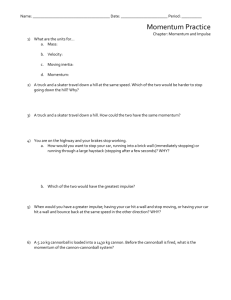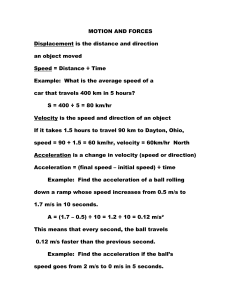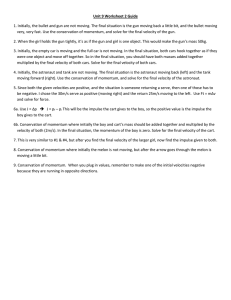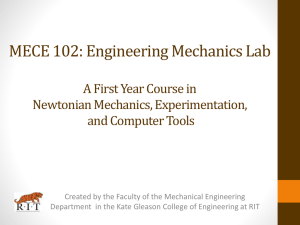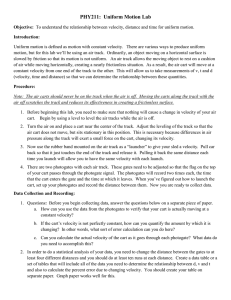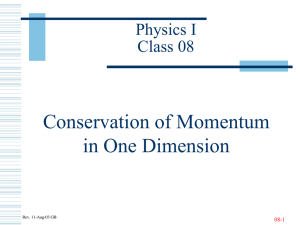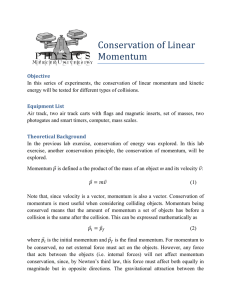Dynamics: Cause of Motion
advertisement
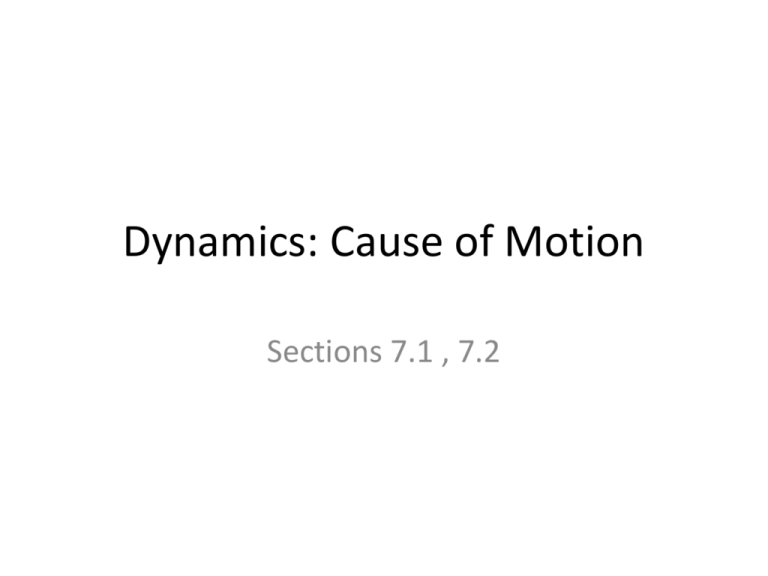
Dynamics: Cause of Motion Sections 7.1 , 7.2 Updates/Reminders • Test #2 has been moved from Tuesday next week to Thursday next week due to a need for more time to prepare for content. • Addresses Chapters 4, 6, and 7. • Next reading quiz due prior to class on Tuesday • LAB A4-PM: Projectile Motion due Friday 4pm • Weekly Reflection #7 sent out on Friday morning • Final Exam Thursday, Dec 11, 10am-12:00pm Conservation of Momentum • Demonstration: the total momentum of an isolated system is conserved. That is, pi = pf if and only if we have an “isolated system” – no unbalanced outside forces. • Example 1 – the collision of carts • Example 2 – the “explosion” of carts • Example 3 – the addition of mass Numerical Problem 1 • A truck with a mass of 3,000kg and a velocity of +20m/s collides head on with a car of 1,500kg mass and a velocity of -20m/s. If the vehicles stick together, what is the resulting motion of the pair? • Solve using conservation of momentum; that is, pi = pf. Numerical Problem 2 • Two dynamics carts are separated by a compressed spring. The mass of cart 1 is twice the mass of cart 2; that is, m1=2m2. The spring is released and the carts fly apart. If cart 1 has a velocity of +3m/s, what is the velocity of cart 2? Numerical Problem 3 • A train car (mass 11,200kg) is moving along at a speed of +2m/s. A 5,000kg mass of coal with no horizontal motion is dropped into the hopper of the train car. What is the resulting motion of the train car now loaded with coal? The Second Law of Motion • a.k.a. Newton’s Second Law • The net instantaneous force acting on an object is precisely the instantaneous change of its momentum per unit time. In symbols, the second law can be written as F = Δp/Δt with Δt very small. • Note that F and Δp are vectors. • Not very enlightening; time for an experiment. Newton’s Second Law • Experiment: – Acceleration as a function of force (constant mass system) – Acceleration as a function of mass (constant force system) • Results: – a is proportional to F – a is inversely proportional to m • Conclusion: F = kma; k=1 if F defined to be in Newtons, N Second Law Reprise • • • • • • F = Δp/Δt F = Δmv/Δt F = mΔv/Δt F = ma Both F and a are vectors; m is a scalar. The sum of forces acting on a body produce an acceleration inversely proportional to mass. • ΣF=ma (where F is expressed in Newtons) 2nd Law Problem – Examples • What is the weight of a person with a mass of 81kg. Note that g = 9.8m/s2. • An car with a mass of 1,500kg accelerates at a rate of -2m/s2 under a constant force. What are the magnitude and direction of that force? • How much force would it take to slow a 75kg person riding in a car going +20m/s to a complete stop if the time was 0.03 seconds – the typical time of an auto collision? More Examples of Newton’s 2nd Law • An object accelerates at a rate of 1.5m/s2 under a force of 53N. What is its mass? • How much upward force does the ground apply to someone with a mass of 75kg to counter balance the pull of gravity? Note that g = -9.8m/s2 and that Fnet = ma and that a = g. • A force of 7.0N is applied to a 3.5-kg mass for 2.0 seconds. What is the change of velocity?




